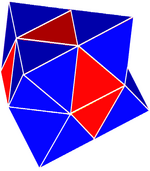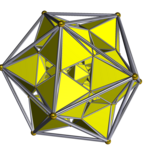Semiregular polytope
| 3D honeycombs | ||
|---|---|---|
 Simple tetroctahedric check |
 Complex tetroctahedric check | |
| 4D polytopes | ||
 Tetroctahedric |
 Octicosahedric |
 Tetricosahedric |
In geometry, by Thorold Gosset's definition a semiregular polytope is usually taken to be a polytope that is vertex-uniform and has all its facets being regular polytopes. E.L. Elte compiled a longer list in 1912 as The Semiregular Polytopes of the Hyperspaces which included a wider definition.
Gosset's list
In three-dimensional space and below, the terms semiregular polytope and uniform polytope have identical meanings, because all uniform polygons must be regular. However, since not all uniform polyhedra are regular, the number of semiregular polytopes in dimensions higher than three is much smaller than the number of uniform polytopes in the same number of dimensions.
The three convex semiregular 4-polytopes are the rectified 5-cell, snub 24-cell and rectified 600-cell. The only semiregular polytopes in higher dimensions are the k21 polytopes, where the rectified 5-cell is the special case of k = 0. These were all listed by Gosset, but a proof of the completeness of this list was not published until the work of Makarov (1988) for four dimensions, and Blind & Blind (1991) for higher dimensions.
- Gosset's 4-polytopes (with his names in parentheses)
- Rectified 5-cell (Tetroctahedric),







- Rectified 600-cell (Octicosahedric),







- Snub 24-cell (Tetricosahedric),






 ,
, 





 or
or 




- Semiregular E-polytopes in higher dimensions
- 5-demicube (5-ic semi-regular), a 5-polytope,








 ↔
↔ 






- 221 polytope (6-ic semi-regular), a 6-polytope,








 or
or 






- 321 polytope (7-ic semi-regular), a 7-polytope,











- 421 polytope (8-ic semi-regular), an 8-polytope,













Euclidean honeycombs
Semiregular polytopes can be extended to semiregular honeycombs. The semiregular Euclidean honeycombs are the tetrahedral-octahedral honeycomb (3D), gyrated alternated cubic honeycomb (3D) and the 521 honeycomb (8D).
Gosset honeycombs:
- Snub 24-cell honeycomb,









- Convex uniform honeycombs, two 3D honeycombs:
- Tetrahedral-octahedral honeycomb or alternated cubic honeycomb (Simple tetroctahedric check),






 ↔
↔ 



 (Also quasiregular polytope)
(Also quasiregular polytope) - Gyrated alternated cubic honeycomb (Complex tetroctahedric check),









- Tetrahedral-octahedral honeycomb or alternated cubic honeycomb (Simple tetroctahedric check),
Semiregular E-honeycomb:
- 521 honeycomb (9-ic check) (8D Euclidean honeycomb),















Hyperbolic honeycombs
There are also hyperbolic uniform honeycombs composed of only regular cells (Coxeter & Whitrow 1950), including:
- Hyperbolic uniform honeycombs, 3D honeycombs:
- Paracompact uniform honeycombs, 3D honeycombs, which include uniform tilings as cells:
- Rectified order-6 tetrahedral honeycomb,







- Rectified square tiling honeycomb,







- Alternated order-6 cubic honeycomb,






 ↔
↔ 



 (Also quasiregular)
(Also quasiregular) - Alternated hexagonal tiling honeycomb,






 ↔
↔ 




- Alternated square tiling honeycomb,






 ↔
↔ 



 (Also quasiregular)
(Also quasiregular) - Cubic-square tiling honeycomb,




- Tetrahedral-triangular tiling honeycomb,




- Rectified order-6 tetrahedral honeycomb,
- 9D hyperbolic paracompact honeycomb:
- 621 honeycomb (10-ic check),

















- 621 honeycomb (10-ic check),
See also
References
- Blind, G.; Blind, R. (1991). "The semiregular polytopes". Commentarii Mathematici Helvetici. 66 (1): 150–154. doi:10.1007/BF02566640. MR 1090169.
{{cite journal}}: Invalid|ref=harv(help) - Coxeter, H. S. M. (1973). Regular Polytopes (3rd ed.). New York: Dover Publications. ISBN 0-486-61480-8.
- Coxeter, H. S. M.; Whitrow, G. J. (1950). "World-structure and non-Euclidean honeycombs". Proceedings of the Royal Society. 201: 417–437. doi:10.1098/rspa.1950.0070. MR 0041576.
{{cite journal}}: Invalid|ref=harv(help) - Elte, E. L. (1912). The Semiregular Polytopes of the Hyperspaces. Groningen: University of Groningen. ISBN 1-4181-7968-X.
- Gosset, Thorold (1900). "On the regular and semi-regular figures in space of n dimensions". Messenger of Mathematics. 29: 43–48.
- Makarov, P. V. (1988). "On the derivation of four-dimensional semi-regular polytopes". Voprosy Diskret. Geom. Mat. Issled. Akad. Nauk. Mold. 103: 139–150, 177. MR 0958024.
{{cite journal}}: Invalid|ref=harv(help)
